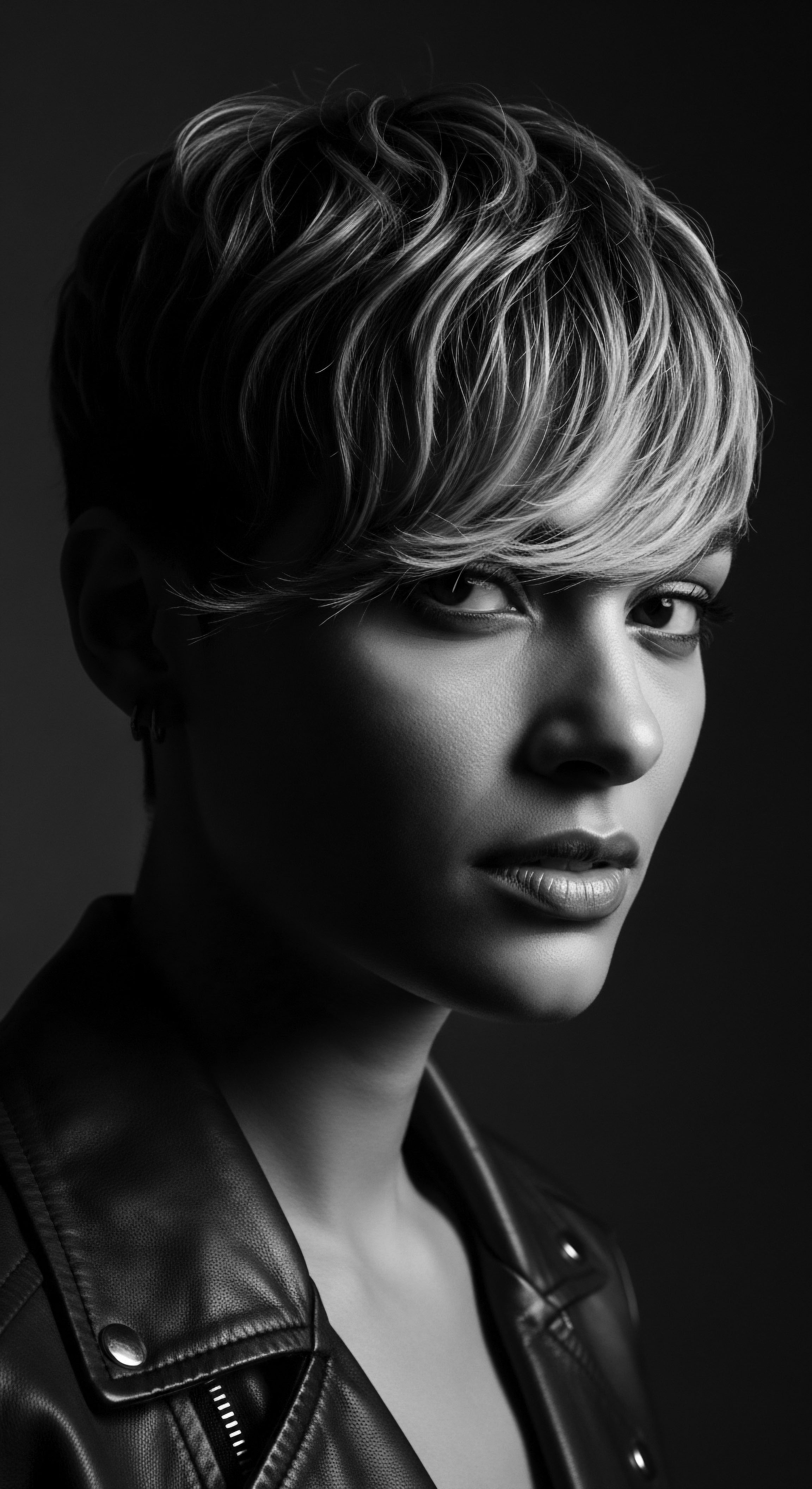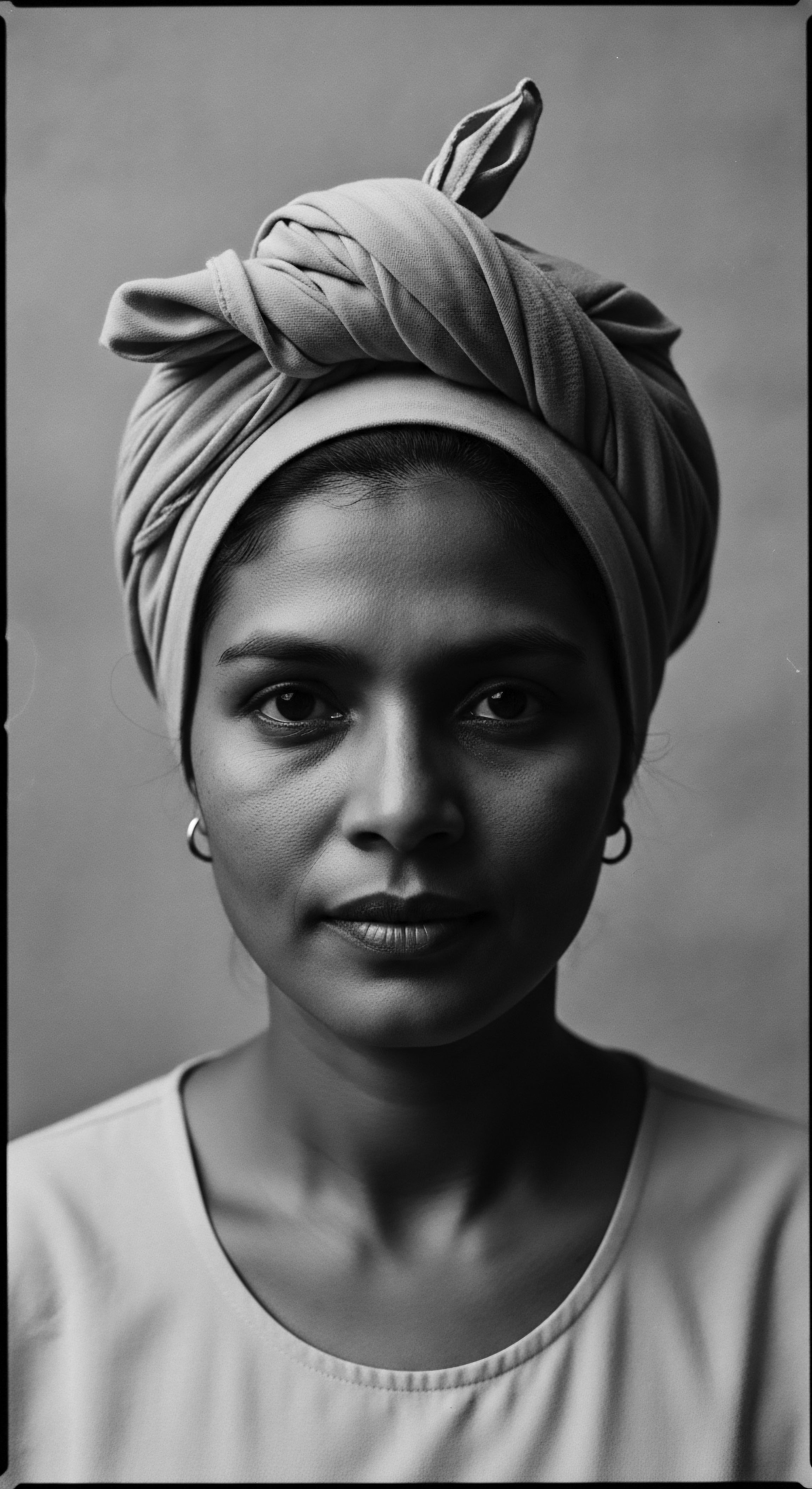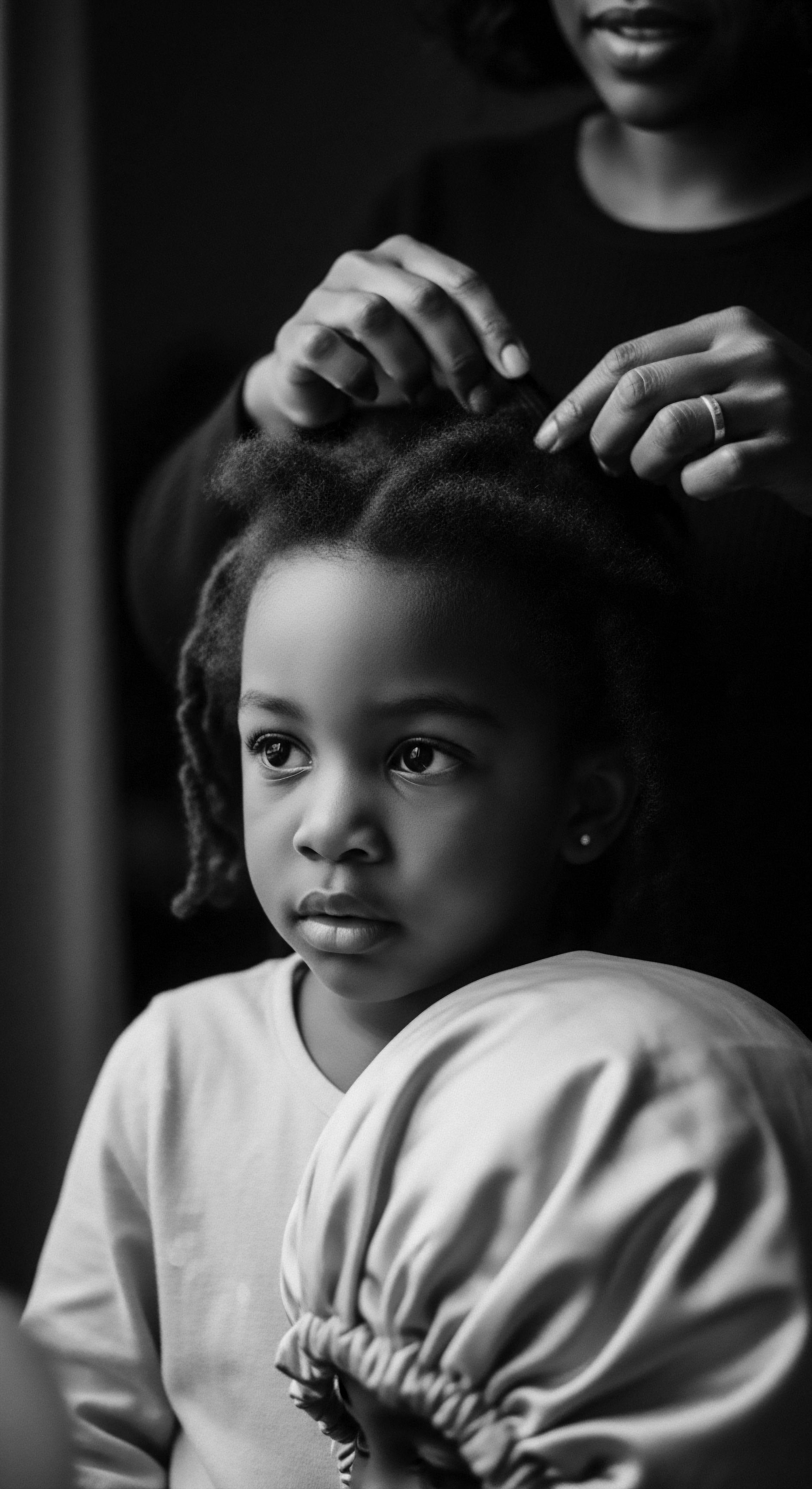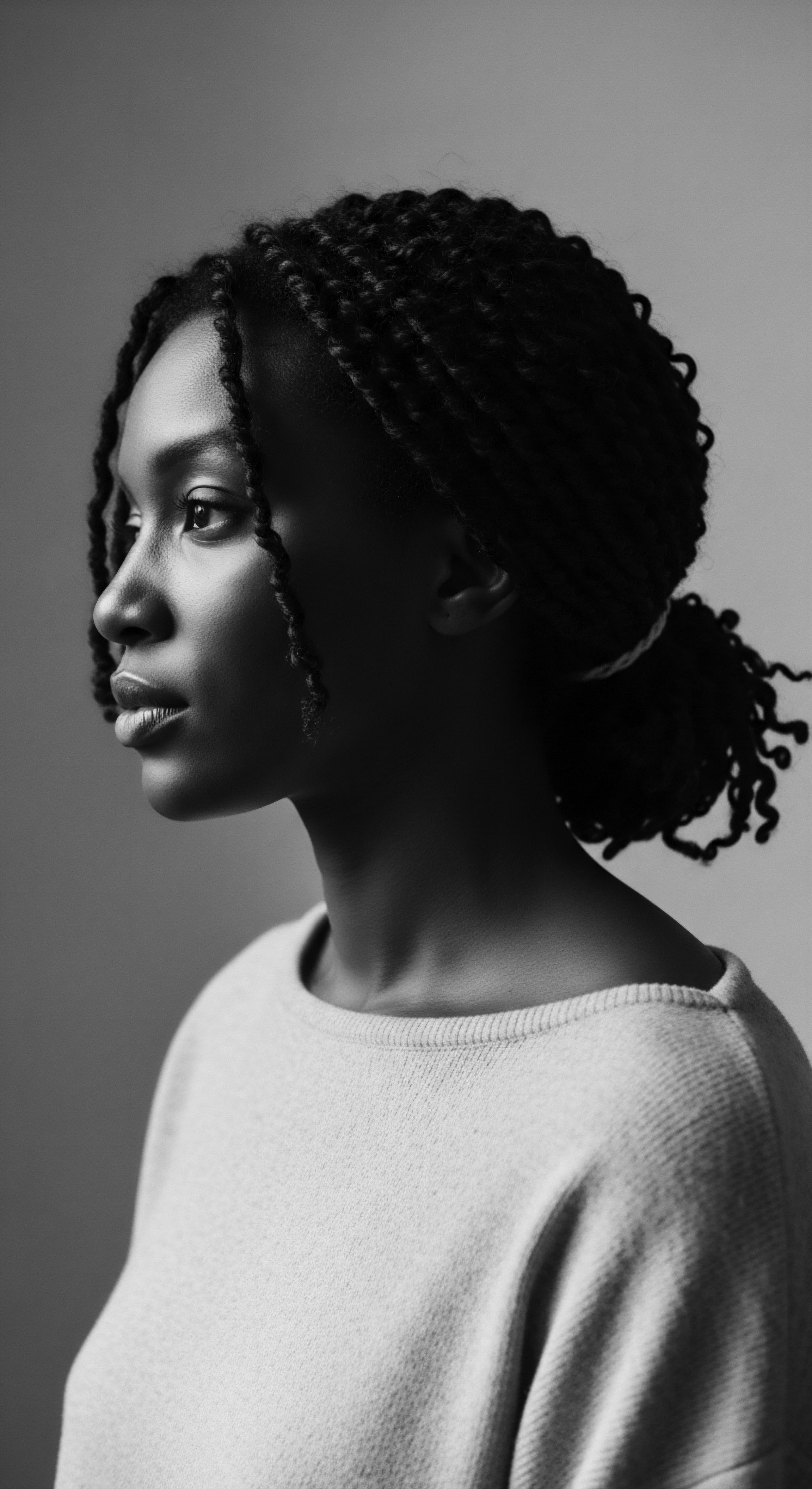
Roots
Consider the very hair gracing our crowns, those intricate spirals and gentle waves that define us. For generations, these strands have served as more than mere adornment; they represent a living archive, holding whispers of ancestral wisdom and the resilient spirit of our lineage. To truly understand the specific requirements of maturing textured hair, we must first journey back to the elemental biology of the strand itself, viewing it through the rich prism of heritage . It is in this profound connection to the past that the efficacy of traditional botanical knowledge unfolds, addressing present-day needs with remedies forged across centuries.
Each coil, each bend, tells a story passed down through the ages. The unique architecture of textured hair, often elliptical in cross-section and characterized by varying degrees of curl, renders it distinct from straighter hair types. This structural difference influences everything from moisture retention to mechanical strength. As textured hair journeys through life, it experiences natural changes, much like the human body itself.
This includes shifts in density, a reduction in the vibrancy of natural color, and sometimes, a tendency toward increased dryness or brittleness. Such changes are not flaws; they are simply manifestations of time, reflections of life lived, and an invitation to reconnect with the enduring botanical wisdom our forebears recognized.

Hair Anatomy and Ancestral Perspectives
The anatomy of textured hair, from the deep curve of its follicle to the varied distribution of its cuticular layers, presents a unique biological blueprint. Unlike cylindrical straight hair follicles, the curved follicle of textured hair causes the hair shaft to grow in a spiral or helical pattern. This curvature, while conferring magnificent visual diversity, also creates points of vulnerability. The cuticle, the outermost protective layer of the hair shaft, tends to lift more readily at these bends, allowing moisture to escape and making the hair susceptible to damage.
From an ancestral viewpoint , these characteristics were not viewed as weaknesses but as natural states that required specific, reverent care. Our ancestors understood, through observation and empirical practice, that certain botanicals could fortify these structures.
The profound relationship between maturing textured hair and traditional botanical remedies lies in a shared lineage of resilience and deep wisdom.
Consider the rich ethnobotanical landscape of West Africa, a source of profound hair care traditions. Plants were not merely ingredients; they were allies, their properties understood through generations of observation and collective experience. For example, the karité tree , yielding what we know as shea butter , was revered not just for its moisturizing properties, but for its role in protection against environmental elements. Its use was deeply intertwined with daily rituals, safeguarding hair from harsh sun and dry winds, a testament to practical knowledge that pre-dated modern scientific analysis but laid its foundation.

Classification and Cultural Biases
The modern systems of hair typing, while useful for contemporary product formulation, often fail to capture the profound cultural and historical context of textured hair. Our ancestors did not categorize hair by numbers and letters but by its connection to identity, status, and community. Traditional African societies, for instance, used hair styles and textures to denote age, marital status, tribal affiliation, and even spiritual roles. The very act of caring for hair, including the selection and preparation of botanical ingredients, was a communal ritual, a passing down of knowledge, rather than a solitary routine dictated by a numerical chart.
- Kinky Hair ❉ Often called coily, this hair type features tight, small curls, forming dense patterns. Its fragility stems from numerous bends where the cuticle can lift.
- Curly Hair ❉ Defined by springy curls, ranging from loose waves to tight spirals. It benefits from moisture retention to maintain its definition and prevent frizz.
- Wavy Hair ❉ Displays a distinct ‘S’ pattern, often less prone to dryness than curlier types but still benefits from botanical care for vitality.
The journey of textured hair through the diaspora has also seen classifications imbued with historical biases. The impact of colonialism and the subsequent adoption of Eurocentric beauty standards often led to the devaluation of natural textures. Yet, throughout this complex history, the knowledge of botanical care persisted, often practiced in quiet resistance, preserving a link to an unyielding cultural heritage .

The Essential Lexicon of Textured Hair
To truly honor the heritage of textured hair care , we must speak its language. This includes understanding the specific challenges that emerge as textured hair matures. Terms like “low porosity” or “high porosity” refer to how well hair absorbs and retains moisture, a critical consideration for aging strands that may become more resistant to hydration.
Traditional practices often intuitively addressed these characteristics. Consider the ancient wisdom of layering oils and water, effectively “sealing” moisture into the hair, a practice observed across many ancestral care regimens.
| Botanical Ingredient Shea Butter |
| Ancestral Use for Hair Moisture retention, scalp conditioning, environmental barrier, traditionally applied to protect hair from sun and wind. |
| Modern Scientific Relevance for Maturing Hair Rich in fatty acids and vitamins A and E; provides emollient properties, reduces transepidermal water loss, offers antioxidant benefits for aging hair. |
| Botanical Ingredient Coconut Oil |
| Ancestral Use for Hair Deep conditioning, scalp nourishment, preventing dryness, often used in pre-wash treatments. |
| Modern Scientific Relevance for Maturing Hair Penetrates the hair shaft to reduce protein loss, offers antimicrobial properties for scalp health, can aid in preserving natural hair strength as it ages. |
| Botanical Ingredient Fenugreek (Methi) |
| Ancestral Use for Hair Promoting growth, strengthening hair, addressing hair loss, and soothing scalp conditions. |
| Modern Scientific Relevance for Maturing Hair Contains compounds that may interact with dihydrotestosterone (DHT), a hormone linked to hair loss; rich in micronutrients and antioxidants beneficial for follicular health. |
| Botanical Ingredient These plant-based allies, passed down through generations, offer a profound continuity in the care of textured hair as it ages, linking past wisdom to present needs. |

Hair Growth Cycles and Influencing Factors
The hair growth cycle, comprising anagen (growth), catagen (transition), and telogen (rest), naturally slows with age. For maturing textured hair, this can mean reduced density and less vigorous growth. Ancestral practices, often intertwined with dietary customs and holistic wellness, implicitly supported healthy hair cycles. Nutrient-rich traditional diets, often abundant in plant-based proteins, vitamins, and minerals, provided the internal scaffolding for robust hair.
The wisdom was not merely topical; it was a holistic understanding of the body as an interconnected system, where what was consumed directly impacted outward vitality. Environmental stressors and even cultural practices like hair manipulation, historically, could influence these cycles. The communal braiding sessions, while serving as social bonds, also offered a gentler approach to hair handling, minimizing stress on the delicate strands.

Ritual
The care of textured hair has always been a ritual, a deliberate act of reverence that transcends mere aesthetics. From ancient African villages to the homes of the diaspora, techniques, tools, and transformations have shaped hair into expressions of identity, community, and artistry. This rich tapestry of practices, deeply rooted in heritage , offers potent answers for the specific needs of maturing textured hair. The traditional botanical knowledge embedded within these rituals provided the very foundation for hair health, often without the explicit scientific vocabulary we wield today.

Protective Styling Through Generations?
Protective styling, a cornerstone of textured hair care, finds its deepest roots in ancestral practices . Styles such as cornrows, braids, and Bantu knots were not simply decorative; they served a practical purpose, safeguarding hair from environmental damage, reducing manipulation, and promoting length retention. For maturing textured hair, which often becomes more vulnerable to breakage and dryness, these traditional styles hold renewed significance.
They offer a gentle sanctuary for strands, allowing them to rest and retain precious moisture. The techniques, passed from elder to youth, are living lessons in preservation.
Consider the meticulous artistry of West African braiding traditions, often taking hours, sometimes days, to complete. This extended process was a communal event, a time for storytelling and the transmission of cultural knowledge. The very act of preparing the hair for these styles involved botanical infusions and nourishing oils, applied to lubricate the strands and condition the scalp. These preparations, often containing shea butter or coconut oil , were integral to the protective function of the styles themselves, forming a barrier against the elements and friction.
Traditional styling methods for textured hair are not just expressions of beauty; they are acts of ancestral wisdom for hair preservation.

Natural Styling and Ancestral Definition Techniques
The pursuit of natural curl definition is not a modern invention. Ancestral communities intuitively understood how to enhance and maintain the inherent coil patterns of textured hair using what was readily available from nature. Techniques like finger coiling, twists, and locs have their origins in antiquity, utilizing botanicals to aid in definition and hold.
For example, plant-based gels derived from flaxseed or aloe vera, while now popular in contemporary natural hair regimens, echo ancient practices of using mucilaginous plants to clump curls and reduce frizz. The aloe vera plant , revered across many cultures for its soothing and moisturizing properties, has been a staple in hair care for centuries, its gel-like consistency providing gentle hold and hydration. As textured hair matures, it can lose some of its natural elasticity and definition. Re-engaging with these traditional, gentle methods, bolstered by botanical emollients, can help restore suppleness and form.
- Twisting ❉ A method of wrapping two sections of hair around each other, often with a botanical cream, to create a defined pattern.
- Braiding ❉ Interlacing three or more sections of hair, a versatile protective style that can also be unraveled for wavy texture.
- Locs ❉ A form of hair grooming where strands are encouraged to interlock, a permanent style with deep historical and spiritual significance.

Hair Enhancements and Cultural Uses
The use of wigs and hair extensions also possesses a long, multifaceted history within Black and mixed-race communities. Far from being solely a modern phenomenon, extensions and hairpieces were employed in ancient African civilizations to signify wealth, status, and tribal identity. While modern extensions often involve synthetic materials, traditional methods frequently incorporated natural fibers or human hair, blended with botanical preparations to maintain their health and integrity. Understanding this historical context allows us to view these enhancements not as a departure from natural hair but as an extension of its artistic and cultural potential, sometimes serving a protective function.

Heat Styling and Historical Contrasts
The advent of heat styling tools brought both convenience and potential for damage, particularly for textured hair. The hot comb , for example, became a transformative tool in the early 20th century, allowing Black women to straighten their hair in ways previously unattainable. Figures like Madam C.J. Walker, a pioneer in Black hair care, created products that accompanied these tools, addressing scalp issues and improving the manageability of hair, though her early formulas still relied on some non-botanical elements like sulfur.
It is important to remember that excessive heat can strip maturing textured hair of its natural moisture and elasticity. While modern science has brought advancements in heat protectants, the core wisdom from our ancestors emphasized minimizing harsh interventions. Traditional practices often favored air drying or low-heat methods, combined with conditioning botanical oils, to preserve the structural integrity of the hair. This cautious approach serves as a reminder to prioritize the long-term health of maturing strands over fleeting stylistic trends.

The Complete Textured Hair Toolkit
The toolkit for textured hair care, past and present, reflects ingenuity and adaptation. Beyond fingers and combs, traditional societies utilized various natural implements. Bone combs , meticulously carved, or wooden picks , designed to gently detangle dense coils, speak to an understanding of hair’s delicate nature.
Even simpler tools, such as gourds for mixing botanical infusions or smooth stones for massaging the scalp, underscore the reliance on natural elements. These tools, used in conjunction with botanical preparations, collectively enabled the complex and attentive care necessary for textured hair.
As textured hair ages, becoming potentially finer or more prone to tangling, the choice of tools becomes even more significant. Gentle wide-tooth combs, soft brushes, and the continued practice of finger detangling, often aided by botanical conditioners, echo the ancestral emphasis on minimizing mechanical stress.

Relay
The wisdom of our forebears, a relay race of knowledge across generations, offers an unparalleled guide for the holistic care of maturing textured hair. This is where traditional botanical knowledge truly shines, informing daily regimens, nighttime rituals, and astute problem-solving, all rooted in an understanding that hair health is inseparable from overall well-being and a profound connection to heritage . Modern scientific inquiry often validates what ancestral practices understood intuitively, forging a powerful synergy.

Building Personalized Regimens From Ancestral Wisdom
A personalized hair regimen, tailored to the evolving needs of maturing textured hair, finds its deepest resonance in ancestral wisdom . Our ancestors did not follow rigid, mass-market protocols; their care was deeply specific, adapting to individual hair characteristics, local climates, and available botanicals. This highly individualized approach, passed down through families and communities, recognized the unique journey of each person’s strands. For maturing hair, this translates to a focus on sustained hydration, gentle cleansing, and consistent nourishment.
For instance, the practice of ‘co-washing,’ or cleansing with conditioner, a popular method today for maintaining moisture in textured hair, mirrors traditional African practices of using conditioning plant extracts or low-lathering natural cleansers that preserved the hair’s inherent oils. The traditional use of plant mucilage from okra or flaxseed to provide slip and moisture during detangling illustrates this principle perfectly.

The Nighttime Sanctuary and Bonnet Wisdom
The night holds particular significance for hair preservation, a truth understood across ancestral practices . Protecting hair during sleep prevents friction, tangling, and moisture loss. The modern silk bonnet or scarf, while seemingly a contemporary accessory, has deep historical roots in the head wraps and coverings traditionally worn by Black women for both cultural expression and practical hair preservation.
These coverings created a ‘nighttime sanctuary,’ a microclimate for the hair, allowing oils and moisture to remain within the strands rather than being absorbed by abrasive fabrics. For maturing textured hair, which can become more brittle and prone to breakage, this protective ritual is not merely beneficial; it is essential.

Ingredient Deep Dives for Maturing Hair Needs?
Traditional botanical knowledge offers a veritable apothecary for maturing textured hair. The ingredients used historically were chosen for their observed efficacy in addressing common hair concerns, many of which intensify with age.
Consider the Chebe tradition of the Basara Tribe in Chad. This ancestral practice, documented in various ethnobotanical studies, involves applying a mixture of powdered Chebe (a specific croton gratissimus plant), along with other herbs and oils, to the hair strands, not the scalp. The hair is then braided or twisted, and the mixture is reapplied weekly. This ritual is observed to significantly contribute to length retention and overall hair health, reducing breakage, a common challenge for maturing textured hair.
The Chebe powder is believed to coat the hair, making it stronger and less prone to brittleness, thereby allowing the hair to grow to remarkable lengths. While comprehensive scientific studies on Chebe are still emerging, the anecdotal evidence and generational consistency of its use offer compelling insight into its efficacy. This practice highlights how traditional knowledge often prioritizes methods that protect the hair shaft from physical stress, a critical need as textured hair ages and its resilience may diminish. The Basara women’s commitment to this practice underscores a deep understanding of hair structure and preservation that has been passed down through their heritage .
Another significant botanical is Black Seed Oil (Nigella sativa) . This oil has been used for millennia in various traditional medicinal systems for a wide range of ailments, including hair loss. Its anti-inflammatory, antioxidant, and antimicrobial properties are particularly beneficial for scalp health, which directly impacts hair vitality, especially as follicles age and become more susceptible to inflammation. While more contemporary research is exploring the mechanisms of its efficacy, its long-standing use for hair issues in traditional contexts points to an empirical understanding of its benefits for supporting a healthy follicular environment.
A case study by Courtois et al. (2000) noted that the diameter of hair shafts, including those with texture, tends to decrease with age, beginning as early as 25 years old. This reduction in diameter contributes to a perception of thinning or reduced density. Traditional botanical practices, by focusing on scalp health and strengthening the hair cuticle, implicitly addressed these age-related changes.
For example, the use of Fenugreek (Trigonella foenum-graceum L.) in many South Asian and African hair traditions for promoting growth and addressing thinning speaks to an ancient understanding of hair density maintenance. Modern research suggests fenugreek may influence DHT pathways, which are linked to hair loss.

Textured Hair Problem Solving Compendium
Maturing textured hair often grapples with dryness, brittleness, and a reduced ability to retain moisture. Traditional botanical solutions offer intuitive and effective answers. For persistent dryness, the layered application of water-based hydrators followed by rich plant oils like jojoba , argan , or castor oil —each with its own historical use in various cultures—creates a seal that locks in moisture. For scalp irritation or flakiness, often exacerbated by aging, botanicals like neem or tea tree oil (diluted, of course) have historical precedents for their soothing and antimicrobial properties.
Hair graying, a universal sign of maturing hair, also has traditional botanical responses. In Traditional Chinese Medicine, Fo-ti (Polygonum multiflorum or He Shou Wu) has been historically used as a longevity tonic, believed to restore hair color and combat premature aging. While scientific validation for direct repigmentation is still being explored, the very existence of such traditions points to ancient attempts to address the visible aspects of hair aging with natural remedies.

Holistic Influences on Hair Health and Ancestral Wellness?
The ancestral approach to hair health was inherently holistic, recognizing that external vitality mirrors internal balance. This viewpoint aligns seamlessly with the specific needs of maturing textured hair. A focus on nutrient-dense diets, stress reduction through communal rituals, and the use of botanical remedies both topically and internally constituted a comprehensive wellness philosophy.
For example, Ayurvedic traditions, originating in India, place significant emphasis on the role of diet and lifestyle in hair health. Herbs like amla (Indian gooseberry) are consumed and applied topically for their perceived benefits in strengthening hair and preventing premature graying, linking dietary intake directly to hair vitality. This ancestral knowledge reminds us that addressing the specific needs of maturing textured hair extends beyond conditioners and oils; it encompasses a way of living that honors the body’s natural rhythms and draws sustenance from the earth. The well-being of the scalp, considered the foundation of healthy hair, was always paramount, a principle that continues to resonate powerfully today.

Reflection
The journey through the intricate world of textured hair, its maturing needs, and the enduring relevance of traditional botanical knowledge leads us to a singular realization ❉ our hair is a living testament to heritage . It is a profound connection to those who walked before us, a repository of wisdom, resilience, and beauty. The Roothea ethos, the ‘Soul of a Strand,’ is not a poetic ideal; it is a call to recognize this deep lineage. The botanicals, the rituals, the very understanding of how to honor textured hair, particularly as it matures, are gifts from our ancestors.
These aren’t merely historical anecdotes or quaint customs. They represent a living, breathing archive of practical science, passed down through generations, often in the face of immense adversity. The efficacy of shea butter, the protective power of ancient braiding techniques, the restorative properties of indigenous herbs—these are not accidental discoveries but the cumulative knowledge of countless lives lived in intimate relationship with the natural world. As we seek to address the nuanced requirements of maturing textured hair today, we find ourselves, time and again, looking back to these wellsprings of wisdom.
Our modern understanding, illuminated by scientific inquiry, only serves to amplify the brilliance of this inherited wisdom. It is a dialogue between past and present, where contemporary findings often serve to validate and deepen our appreciation for what was instinctively known. By engaging with this knowledge, we are not simply caring for our hair; we are engaging in an act of profound self-acceptance, a celebration of identity, and a continuation of a vibrant cultural legacy .
The health of each strand becomes a quiet act of defiance against erasure, a vibrant affirmation of who we are and from whom we came. The future of textured hair care, then, is not about innovation alone; it is about reconnection, about remembering, and about carrying forward the soulful care that has always been our heritage.

References
- Courtois, M. et al. “A Comment on the Science of Hair Aging.” Journal of Cosmetic Science, vol. 51, no. 5, 2000, pp. 273-281.
- Abdullah, Ghanima. “Indian Home Remedies for Hair Growth ❉ 8 Ayurvedic Tips for Lustrous, Healthy Locks.” Healthline, 25 May 2021.
- Bundles, A’Lelia. “Black Hair Care Made Madam C.J. Walker America’s First Self-made Female Millionaire.” HowStuffWorks, 16 June 2020.
- Bundles, A’Lelia. “Roots of Black Hair Care.” Living on Earth, 14 June 2024.
- Enujiugha, V. N. et al. “A Review Of Indigenous Therapies For Hair And Scalp Disorders In Nigeria.” Journal of Cosmetic Dermatology, vol. 23, no. 12, 2024, pp. 4165-4176.
- Farah, A. et al. “African Beauty and Skincare ❉ A Deep Dive into History, Traditions, and Natural Ingredients.” The African Exponent, 16 Jan. 2025.
- Khan, H. et al. “Anti-aging Effects of Select Botanicals ❉ Scientific Evidence and Current Trends.” Cosmetics, vol. 5, no. 4, 2018, p. 54.
- Kumar, A. et al. “Development and Evaluation of Herbal Hair Serum ❉ A traditional way to Improve Hair Quality.” Journal of Drug Delivery and Therapeutics, vol. 11, no. 4, 2021, pp. 106-111.
- Mbeng, W. and I. Sagbo. “Ethnobotany of traditional plant cosmetics utilized by women; A study in Northern Ghana.” Pharmacognosy Reviews, vol. 12, no. 24, 2018, pp. 139-156.
- Nishimura, E. K. et al. “Hair graying is caused by defective self-maintenance of melanocyte stem cells.” Cell, vol. 123, no. 6, 2005, pp. 1191-1201.
- Opara, P. et al. “Hair Care Practices from the Diaspora ❉ A Look at Africa, America, and Europe.” Hair Journey, 23 Jan. 2025.
- Osadebe, A. A. et al. “Cosmetopoeia of African Plants in Hair Treatment and Care ❉ Topical Nutrition and the Antidiabetic Connection?” Diversity, vol. 16, no. 2, 2024, p. 96.
- P. S. Anupama, et al. “Ayurvedic Hair Care Tips for Your Kerala Vacation.” Lotus Botanicals, 10 June 2024.
- Singh, K. et al. “Indian Hair Care Regimens ❉ Timeless Wisdom for Modern Hair.” The Earth Collective, 29 Sep. 2023.
- “No raw oils and butters vs. Traditional African hair care?” Reddit, 26 Aug. 2021.
